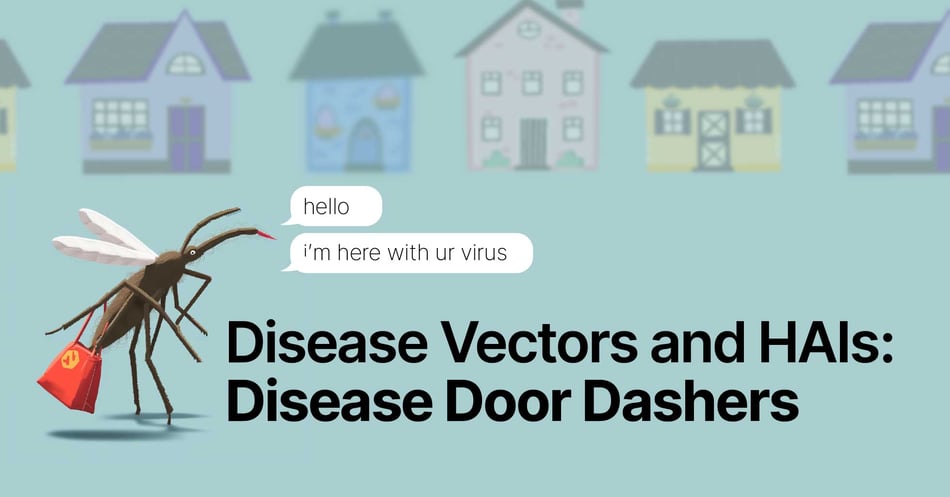Disease Vectors and HAIs: Disease Door Dashers

New England has been put on high alert thanks to an outbreak of Eastern Equine Encephalitis (EEE), a rare virus that can lead to the deaths of 30% of those infected, and leave many survivors with neurological problems. Despite the name, (the second E, equine, means "horse") this virus is spread by mosquitos, an example of what is known in the medical field as a disease vector. In today's post, we'll look at what a vector is, and how they play a role in the spread of healthcare-associated infections.
We love to unpack words here, so let's start by looking at the word vector. While many of us may have first met this word in a mathematics classroom learning about lines and directions, the origin of the word is closer to the medical definition: Latin vector means "carrier," someone who carries an item from one place to another. A disease vector is just that: A living organisms that carries a disease or parasite from one host to another.
Mosquitos are not the only vectors, but its role in the transmission of disease makes this buzzing creature the most deadly animal. Malaria, dengue, West Nile, yellow fever, Zika, chikungunya, and many others could not spread without the assistance of a mosquito, whose bite both picks up and deposits viruses directly into the bloodstream of mammals, including humans. Another notorious biting insect helps (yes, it still does) spread the Black Death and plague throughout the world, to devastating efficiency: The flea. Similarly, lice can spread typus, ticks can spread Lyme disease, and tsetse flies can spread sleeping sickness. Some diseases are spread through a vector's body or waste products. Rabies is an example of a virus that is spread through a vector's saliva, mostly through a bite. Aquatic snails' larvae can infect a person swimming in contaminated water, transmitting the disease schistosomiasis. Bats are a particularly effective disease vector, as they can become a reservoir for many viruses that do not make them sick but can be deadly to those they bite.
Can Humans Be Vectors?
Yes, we carry and transmit disease, but the term is usually reserved for non-human living things. However, the science behind the transmission is the same. When we become infected with a viral disease, we start carrying it around, become a reservoir for that disease. We become vectors if we then pass it on to someone else via sneezing, touching, or other direct transmission. We can also pick up viruses that affect other organisms (but not humans) and transmit that virus. For example, the tobacco mosaic virus does not affect humans, but we can pick it up and pass it from plant to plant.
Humans Spread Healthcare-Associated Infections (HAIs)
One could consider humans as a major vector in the transmission of healthcare-associated infections. Contaminated hands lead to contaminated surfaces, and both can come into contact with vulnerable hosts. While viruses depend on the host to stay alive long enough to transmit the disease, bacteria can survive on their own, making them a particularly challenging source of HAIs. Bacteria can be picked up by hands and surfaces and survive there for days, months, and even years, just waiting for the right environment to begin reproducing. The ideal environment is a vulnerable host, such as an immunocompromised patient.
Safety Through Prevention
There are many precautions to avoid contact with a potential disease vector. For example, people in New England are being urged to stay inside, and if they do venture out, to wear mosquito repellant and long pants/sleeves. In areas with contaminated water sources, people learn to boil their drinking water and avoid swimming in contaminated water. Vaccines exist for many vector-borne diseases, protecting the host before exposure. But how about with HAIs?
Preventing HAIs means breaking the chain of transmission between contaminated hand, contaminated surface, and vulnerable host. Handwashing and room disinfection is key, but leaves gaps where bacteria can persist and still reach a host. Rooms are only disinfected once per day, and hand-washing is notoriously inconsistent. The best prevention in healthcare settings is the use of biocidal materials for surfaces that become disease reservoirs: Bed rails, overbed tables, and countertops. These surfaces continue to become contaminated between daily disinfection, becoming dangerous reservoirs. If these surfaces could remain at benign levels of contamination, where levels are low enough to make the risk of transmission negligible, we could remove the risk posed by HAI's primary vector: Ourselves.
![EOScu Logo - Dark - Outlined [07182023]-01](https://blog.eoscu.com/hubfs/Eoscu_June2024/Images/EOScu%20Logo%20-%20Dark%20-%20Outlined%20%5B07182023%5D-01.svg)




